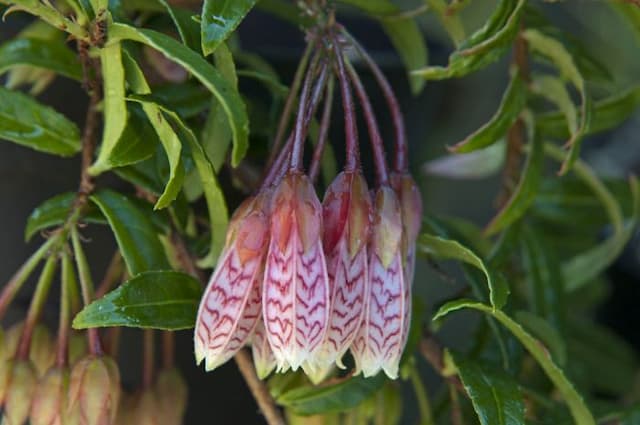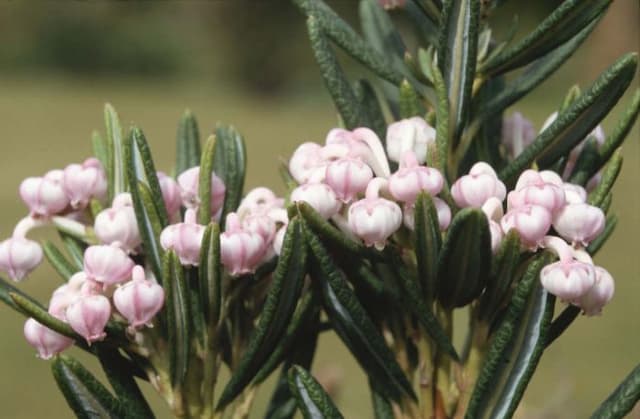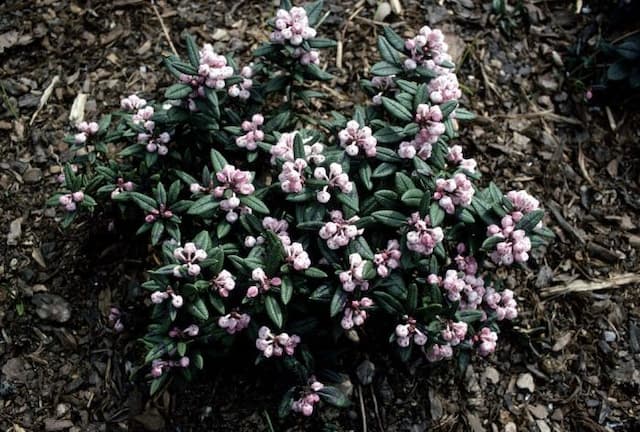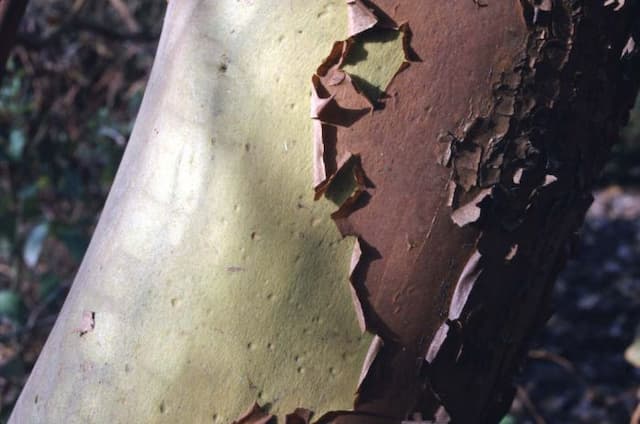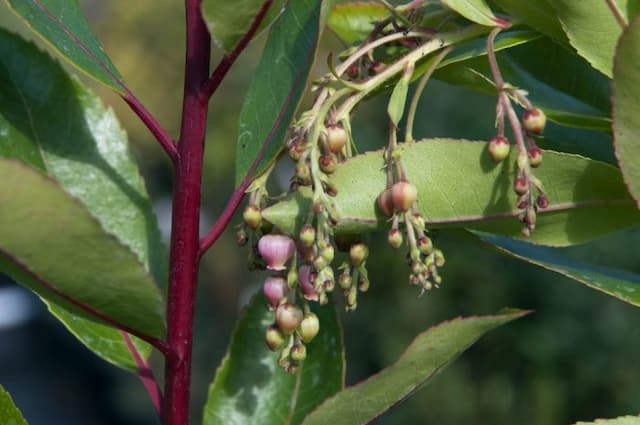Winter Heath Erica carnea 'Ann Sparkes'
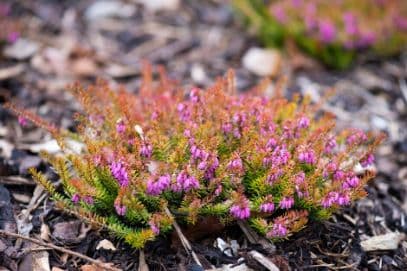
ABOUT
Erica carnea 'Ann Sparkes', commonly known as winter heath or spring heath, is an evergreen perennial shrub that is appreciated for its striking appearance in the garden. Its foliage is made up of small, needle-like leaves that are bright green, providing a vivid backdrop for its flowers. The leaves are closely packed on the stems, giving the plant a dense, bushy look. The most distinctive feature of winter heath 'Ann Sparkes' is its vibrant blooms. The flowers are bell-shaped and typically boast a bright magenta or pink color, providing a splash of color during the colder months or early spring when many other plants are still dormant. These flowers are small and grow in clusters, creating a carpet of color that is particularly eye-catching against the green foliage. The overall impression of Erica carnea 'Ann Sparkes' is of a plant that is both lush and vibrant, with its luxurious green leaves and richly colored flowers offering a contrast that can brighten up any garden. Its evergreen nature ensures that it remains attractive throughout the year, while the winter to spring blooming period means that it can provide a welcome touch of color when many other plants are not in flower.
About this plant
 Names
NamesSynonyms
Winter Heath, Spring Heath, Alpine Heath.
Common names
Erica carnea 'Ann Sparkes'.
 Toxicity
ToxicityTo humans
Winter heath (Erica carnea 'Ann Sparkes') is not typically considered to be toxic to humans. However, as with any plant, individual allergies or sensitivities can occur. If someone has a known sensitivity to Erica species, they might experience discomfort or an allergic reaction upon handling or ingesting the plant. Ingesting significant quantities could potentially lead to gastrointestinal discomfort or more serious complications, particularly in individuals with a sensitivity to the plant. It is always advisable to keep any plant material out of the reach of small children who might accidentally ingest it.
To pets
Winter heath (Erica carnea 'Ann Sparkes') is not commonly listed as a toxic plant to pets such as cats and dogs. Although not specifically known to be poisonous, it's generally a good practice to prevent pets from ingesting plants as they may cause gastrointestinal upset or an allergic reaction, especially if the pet has a specific sensitivity to the plant. If a pet does ingest winter heath and you notice any unusual symptoms or behaviors, it is best to consult a veterinarian.
 Characteristics
CharacteristicsLife cycle
Perennials
Foliage type
Evergreen
Color of leaves
Green
Flower color
Pink
Height
6 inches (15 cm)
Spread
12 inches (30 cm)
Plant type
Shrub
Hardiness zones
5
Native area
Europe
Benefits
 General Benefits
General Benefits- Low Maintenance: Erica carnea 'Ann Sparkes', commonly known as winter heath, is renowned for its ease of care, requiring minimal attention once established.
- Drought Tolerance: It has good drought tolerance, making it suitable for xeriscaping and low-water gardens.
- Winter Bloom: Winter heath offers vibrant color in the winter landscape when few other plants are in bloom, with its bright pink flowers.
- Attracts Pollinators: Its flowers attract bees and other pollinators, which are crucial for the health of ecosystems and the pollination of many other plants.
- Ground Cover: It is an excellent ground cover plant, helping to prevent soil erosion and suppress weeds in the garden.
- Year-Round Interest: The plant provides four seasons of interest with its evergreen foliage and long flowering period.
 Medical Properties
Medical PropertiesThis plant is not used for medical purposes.
 Air-purifying Qualities
Air-purifying QualitiesThis plant is not specifically known for air purifying qualities.
 Other Uses
Other Uses- Winter Garden Interest: Erica carnea 'Winter Heath' provides color during the winter months when most other plants are dormant, livening up dreary landscapes.
- Groundcover: Winter Heath can be used as an effective groundcover in areas prone to erosion, helping to stabilize soil with its dense mat of roots.
- Bonsai: Some enthusiasts use Winter Heath for creating bonsai, due to its small leaves and potential for interesting shapes.
- Photography: Its vibrant flowers make Winter Heath a popular choice for photographers looking to capture the beauty of winter blooms.
- Educational Tool: Botany educators may use Winter Heath to teach about plant adaptations to cold environments, as it thrives in alpine and subalpine conditions.
- Artistic Inspiration: Artists may draw inspiration from the bright colors and textures of Winter Heath for various forms of art, including painting and textile work.
- Themed Gardens: Winter Heath is ideal for winter-themed gardens or as part of a collection showcasing seasonal interest plants.
- Container Gardening: Because of its compact size, Winter Heath is suitable for growing in containers, allowing those with limited space to enjoy its beauty.
- Eco-Friendly Lawn Alternative: Using Winter Heath as a lawn substitute can reduce the need for mowing and conserve water.
- Wildlife Habitat: While it isn't its primary use, Winter Heath provides shelter and foraging opportunities for small wildlife, especially during sparse winter months.
Interesting Facts
 Feng Shui
Feng ShuiThe Winter Heath is not used in Feng Shui practice.
 Zodiac Sign Compitability
Zodiac Sign CompitabilityThe Winter Heath is not used in astrology practice.
 Plant Symbolism
Plant Symbolism- Endurance: Erica carnea, commonly known as Winter Heath, is a plant that thrives in cold, winter months, symbolizing the ability to endure and persevere through difficult conditions.
- Protection: Traditionally, heaths have been associated with protection as they were believed to guard against negative forces and were used in homes to keep the indoor environment pure.
- Solitude: As a plant that often grows in secluded, wild areas, Winter Heath can represent a love for solitude and the enjoyment of one's own company in peaceful settings.
- Good Fortune: In some cultures, heather plants are symbols of good luck, and gifting them is believed to bring good fortune and prosperity to the recipient.
- Admiration: The delicate, yet vibrant, flowers of the Winter Heath can symbolize admiration and beauty, often used to express appreciation for the natural elegance of someone's character or presence.
 Water
WaterWinter heath, commonly known as 'Ann Sparkes,' should be watered regularly to maintain moist but not soggy soil conditions. Typically, this means watering with about 1 gallon per plant every week during active growth periods in spring and summer, but always check the top inch of soil for dryness before watering. Reduce watering frequency in the fall and water sparingly in winter, as the plant is more drought-tolerant during dormancy. Ensure proper drainage to prevent water-logging which can lead to root rot. During extended dry periods, additional water may be necessary.
 Light
LightWinter heath thrives best in full sun to partial shade. A location that provides at least four to six hours of direct sunlight per day is ideal for 'Ann Sparkes'. If you are planting it in a hotter climate, provide some afternoon shade to protect the plant from intense heat. Avoid deep shade which can lead to sparse growth and fewer flowers.
 Temperature
TemperatureWinter heath 'Ann Sparkes' is hardy and adaptable, ideally thriving in temperatures ranging from 20 to 70 degrees Fahrenheit. The plant can tolerate temperatures down to 0 degrees Fahrenheit, making it suitable for many temperate regions. Conversely, it can handle brief periods of heat but sustained temperatures over 75 degrees Fahrenheit may stress the plant.
 Pruning
PruningPrune Winter heath 'Ann Sparkes' immediately after flowering to maintain its shape and encourage bushier growth. Typically, this is done in late spring. Lightly trim old flower stalks and any straggly growth, but avoid cutting back into old wood that does not have leaves, as this can prevent new growth. Pruning on an annual basis is sufficient for this low-maintenance shrub.
 Cleaning
CleaningAs needed
 Soil
SoilWinter Heath 'Ann Sparkes' thrives in well-draining, acidic soil with a pH between 4.5 and 6. A mix of peat moss, sand, and loamy soil is ideal, promoting good drainage and providing the right nutrient balance for this plant.
 Repotting
RepottingWinter Heath 'Ann Sparkes' should be repotted every two to three years to refresh the soil and accommodate root growth. The best time for repotting is in the spring after the plant has finished flowering.
 Humidity & Misting
Humidity & MistingWinter Heath 'Ann Sparkes' prefers moderate humidity but is quite adaptable to different humidity levels, making it suitable for most outdoor garden environments where it typically thrives.
 Suitable locations
Suitable locationsIndoor
Place Winter Heath 'Ann Sparkes' in bright light with acidic soil.
Outdoor
Plant in well-drained, acidic soil, full sun to partial shade.
Hardiness zone
4-7 USDA
 Life cycle
Life cycleErica carnea 'Ann Sparkes', commonly known as Winter Heath, begins its life cycle as a seed which germinates in late spring to early summer, preferably in a well-drained, acidic soil. After germination, the seedling grows and develops into a young plant, establishing a root system and foliage. Over the following months, the plant enters a vegetative state, where it matures and expands through vegetative propagation, creating a dense mat of evergreen foliage. As it reaches maturity, usually within 2 to 3 years, Winter Heath produces vibrant bell-shaped flowers in late winter to early spring, usually pink to purplish-pink in color. After the flowering period, the plant sets seed which disperses to start new plants, completing its reproductive cycle. Winter Heath is a perennial, so after seed set, it goes into a period of growth dormancy during the warmer summer months before resuming growth and preparing for the next flowering cycle.
 Propogation
PropogationPropogation time
Early Spring
The most popular method for propagating Erica carnea 'Ann Sparkes', commonly known as winter heath, is by semi-ripe cuttings. This process usually takes place in late summer. To do this, a gardener selects a healthy, non-flowering shoot and cuts a piece about 2-4 inches (5-10 cm) long. The lower leaves are stripped, and the cut end is dipped in rooting hormone to encourage root development. These cuttings are then inserted in a mix of peat and perlite and kept in a humid environment until roots have established, which may take several weeks. After rooting, the cuttings can be transplanted into individual pots to grow on before being planted out into the garden.
